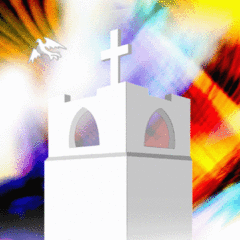I was recently asked by a parishioner about the biblical prohibition against “graven images” in the Ten Commandments. And since it is the heartfelt desire of every Christian believer to love God, I have heard this particular concern many times over the years regarding Christian sculptures, carvings, etchings, icons, paintings and other artwork that depict Jesus, or his family, or his early disciples, or great Church leaders of history (i.e. Martin Luther, John Wesley, and others).
In the Ten Commandments of Exodus 20, it says the following: “I am the Lord your God, who brought you out of the land of Egypt, out of the house of slavery; you shall have no other gods before me. You shall not make for yourself any graven images—any likeness of anything that is in heaven above, or that is on the earth beneath, or that is in the water under the earth; you shall not bow down to them nor serve them.”
Based on this Bible text, some Protestant Christians (as well as all Muslims and most Jews) assert that sculptures and icons of Jesus Christ, or statues of saints and angels, or paintings of holy images, are all violations of Exodus 20. But is this really the case? Are we breaking the commandment of God by having statuary, icons and other images of either earthly or heavenly subjects in our homes and churches?
To more fully understand Exodus 20, we need to use the principle of interpreting Holy Scripture with Holy Scripture. So let’s look at other Bible passages that can shed light on this commandment of God from Exodus 20…
- The prohibition against “graven images” in Exodus 20:4 and “molten gods” in Exodus 34:17 are both given in the context of the idolatry of the ancient Near East.
- God commanded that gold images of cherubim (winged angels of heaven) be made and placed on the lid of the Ark of the Covenant. See Exodus 25:18-22.
- God commanded that cherubim images be fashioned on the curtains of the Tabernacle. See Exodus 26:1.
- God commanded that cherubim images be on the veil of the Tabernacle that separated the Holy Place from the Most Holy Place (“Holy of Holies”) where the Ark was placed. See Exodus 26:31.
- In First Kings 6:23-28, the Jerusalem Temple had two large gold-overlaid olivewood cherubim on either side of the Ark in the Holy of Holies.
- Also in First Kings 7:13-51, the Jerusalem Temple had oxen sculptures holding up the bronze laver (large water basin), and the base of the laver had earthly images of lions and oxen, as well as heavenly images of cherubim.
- The Lord God commanded Moses in Numbers 21:8-9 to make a bronze serpent and set it on a pole as a means through which the Israelites would receive grace for healing from wilderness snakebites. See John 3:14-16 for Jesus’ comparison of his New Testament ministry and crucifixion with the healing grace of the Old Testament bronze serpent and pole.
Now, in light of the Bible passages listed above (and their historical contexts), it is clear that an absolute rejection of all manmade images of earthly and heavenly things is not God’s intention. Consequently, those who interpret Exodus 20:3-4 as prohibiting any and all images do not agree with the interpretation of Moses and Solomon (according to God’s intention) — and we clearly see this fact by interpreting Holy Scripture with Holy Scripture, and by interpreting Holy Scripture within its various historical contexts.
Therefore, the main thing in Exodus 20:2-6 is simply to NOT worship lesser gods, and to ONLY worship and serve the One Almighty God of All. Moreover, the Bible is warning us of the error of venerating the manmade thing (the handcrafted image) rather than focusing on the creative Source of all good things (the Eternal God). So while we can conclude that Christian statuary, icons and other artwork are permissible by God for reminding us of (and pointing us toward) his eternal grace and truth, we must never fall into worshiping such images. In other words, the prohibition in Exodus 20 is not the production of graven images per se, but the bowing down and serving of such images (see also Deuteronomy 5:8-10).
Similarly, Lutheran Christians do not bow down to and do not worship/serve images of Christ, or of his Apostles, or of past and present Church leaders. However, we can and do include such sacred images in our homes and churches, and this is all well and good as long as we use these beautiful things appropriately in order to worship and serve only the Lord God Almighty.
Lastly, as Lutheran Christians who believe, trust and profess that Jesus Christ is the Son and Living Icon of God with us, we make and use sacred Christ-centered images as helpful tools in sharing the good news of Jesus within a world constantly flooded by ungodly images of all sorts. After all, “The Son is the image of the invisible God, the firstborn over all creation” (see Colossians 1:15-20).
Together in Christ’s Mission, Pastor Tim
